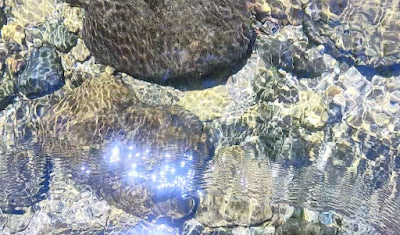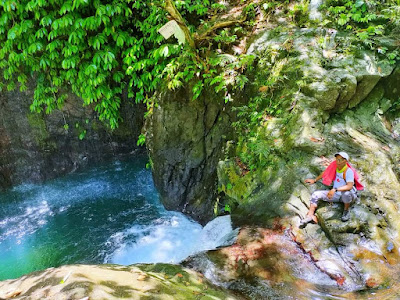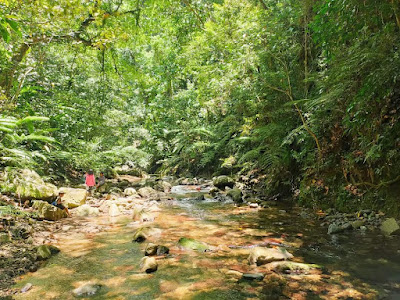THE ENIGMA OF NEGRO CAVE: UNCOVERED
📌 Negro Cave (Cueba Negro), Sicalao, Lasam, Cagayan, Philippines
"The array of geological formations at Sicalao was preternatural. So was the wildlife and its countless natural dignified wonders not so known to the ordinary."
I spent so many years roaming the great outdoors and into the wild in pursuit of how I would be able to quench the thirst of going outside where I can truly find the world of enchantment I am looking for. Not in gigantic malls. Never in crowded parks. Neither in romantic theaters, nor in fancy restaurants.
I was not so coerced and impressed with modernized marvels created by human technologies but rather by the sceneries sculpted by the Earth's innate forces and the nurturing of Mother Nature.
 |
| Over the years of exploring into the wild and the great outdoors |
I was dreaming of trekking the vastness of the Amazon, conquering the peaks of the lofty Kilimanjaro, enduring the aridity of the Australian Outback or even braving the hostility of the Antarctic realm. But I could never fool myself into thinking I was in some dream place of nowhere. After all, I was in Sicalao, the incontestable and the last ecological frontier of Lasam, Cagayan.
The last, the largest and the wildest, Sicalao lies east of the still formidable Cordillera hemlines and southwest of the municipality; amid of it, runs the prowess of the life-giving Zinundungan river, paving the way to the geological rise of the great Zinundungan Valley .
 |
| Colorful gecko, a testimony of Sicalao's rich biodiversity |
Much, if not all of Sicalao's inventories of its natural benisons are tucked hidden on the massive tropical rainforests and limestone mountains near its border in Flora, an adjacent municipality in the province of Apayao.
This positioning cleaves a realm where potentiating extremes engage in one of nature's most fascinating dramas of duality: wetness and wildness; the wetter, the wilder. And the continuous barrage of alternating wet and dry shapes the indefinable landscapes of Sicalao that conceal its unknown charms only the seasoned outdoorsy could find.
 |
| Tropical Sicalao supporting myriad of wildlife |
That one fine, misty morning, accompanied by my support team led by Ka Ali Cabison, I pinned my map and geo-tagged my GPS to the unknown of Sicalao, the last frontier; uncharted and unfamiliar. It was strange; unnerving to explore one of the most fearsome, unnoticed, unpublished caves in the entire town.
 |
| Explore Lasam™️ Team, with lead guide Ali Cabison (2nd from left) |
But the magnanimity of my spirit with my insatiable quest for new amazement has brought me into the hell-like interior of the blackened Negro Cave...
It was a huge mystery relief that I was eventually able to uncover the enigma of its namesake, "negro" which meant "black".
 |
| The Negro Cave lives up to its namesake: "black" |
Not so many people know about the Negro Cave though, even among the people of its locality. While Sicalao is the most visited destination in Lasam because of its clean rivers, majestic waterfalls and the iconic Sicalao Bridge popular to the mob, its caves remain as the less frequented ports of call to any visitor.
For decades since its first footing, no more than a dozen of single individuals have invaded Negro Cave; probably fewer than the humans that went to the moon. It was almost hidden and creepy.
 |
| More people went on the Moon than in Negro Cave |
This narration by Mang Jerry Lomibao, one of my guides and among the first known raider of this dark, black cave only stirred my curiosity and craving for "pioneerism".
For me, it is always been great to be the first, if not among the firsts; the very few firsts.
It's not all about feeding our egoistic tendency but rather, it's all about our delicate chance to see the most raw, the most beautiful, the most natural and the most untouched form of that wonderful place taken into account before they could be vandalized, defaced or humanized.
 |
| Documenting the Negro Cave before it will be totally humanize |
"There is a mystic and a magic to this place", I sighed.
Negro's spacious double domes are empty in many ways and yet, full in others. There's nothing so special as to be inside pointing my torch into its walls full of draperies, some flowstones, columns and helictites - all in monochromatic black to grayish hue. Its commanding dark color was so bizaare for a cave that is found in Sicalao. Most of the others, including the Isus Cave and Abot de Sicalao Cave (both previously featured) are white to brownish due to the natural hue of the calcite and limestone. The Negro Cave lacks the usual defining characteristic of a cave - stalactites and stalagmites; the major speleothems in general.
 |
| Lacking the usual speleothems or cave formations |
Therre might be some, but not that conspicuous or very pronounced. It is bleak in its natural state, yet it has something grabby inside - a gushing and cold river stream seeping and oozing from somewhere else underground.
Its ceilings are not adorned by imaginative formations of stalactites, anthodites or other speleothems. But rather a regularly arranged circular depressions in light color decorate the overheads, with protrusions in a sea waves resemblance.
 |
Extravagant ceiling of the Negro Cave
|
From its nothingness, life still teems silently. Forest crabs could be seen in the streams of running water inside this vastness of unending night. Whip scorpions, crickets and frugivorous and insectivorous chiropterans not on swarms are the normal residents.
The cave walls are constantly wet, and not too many bats find Negro as their comfort dwelling of choice.
 |
| The dark, black, constantly wet interior of Negro Cave |
Resembling as lava rocks, the black, darkened scapes of Negro could have been due to fungi growth, atleast for one reason. Breathing caves pull in air from the surface as barometric pressure rises so there are fungal spores in the cave. A fungus can live without any sunlight as long as it has a source of energy. That source is biomass that gets washed into the cave, so we normally see no life deep within cave except for the rare forms of extremophiles that have adapted to some source to replace breaking down biology, such as sulfur or hydrocarbon feeding.
 |
| The black hue may be due to mineral lints or fungal growth |
Another reason for its charcoal-charred appearance could be due to the byproducts of bacteria that can photosynthesized in total darkness. Or could be the natural state of the sedimentary rocks that formed this specific cave.
Or does it suggest a possible coal deposits?
Regardless of the reason, Negro Cave is stunning in its bleakness. It is more interesting in its lackness than in what it has to offer.
 |
| The Negro Cave, beautiful in its nothingness |
This abyssal landscape possesses an alien, other-worldly feels, worse to compare - the Hades, literally the underworld. Gray and black dominate a minimalist spectrum ruled by walls of rocks and very little else. Soil hardly exists. The flooring is cobbled with limestones, with occasional cave corals or coralloids.
This barren immensity of the underworld was beautifully crafted by the Earth's fiery eons ago.
 |
| Sculpted by time millions of years ago |
In 1961, the "Sicalao Limestones" was defined by scientists Durkee and Pederson in reference to the limestones that can be found in the western flank of Cagayan, facing the Cordilleras. Sicalao thus, sits on unconformable volcanic rocks and can be traced continuously from Luna, Apayao to the north, southward to Salegseg in Kalinga province.
Its stratigraphic position suggests a probable Late Oligocene age or about 30 million years ago.
 |
| Millions of years old |
And so, this timeless splendor of the land before time continue to exist to amaze us. Negro Cave, an underrated outdoorsman's paradise has never failed me to project an awesome sight, exhilarating and utterly breath-taking extravagance of nature.
 |
| Extravagance of nature |
As we left the place, there in my unflappable mind, I was already anticipating prospect of another memorable day on a land not as perfect as the Amazon, Kilimanjaro, Australia or Antarctica but equally intriguing and fascinating.™️
More:
https://m.facebook.com/story.php?story_fbid=pfbid0GTCEWkPxS1dj4XrHDGZ3CzJNAJnxytZoALCqaWYDpZE9g5YDmzhGxGyTxxk6gse9l&id=100007283687906
https://m.facebook.com/story.php?story_fbid=3185458988373526&id=100007283687906
#Sicalao #IntoTheWildSeries #TheGreatOutdoors




















































